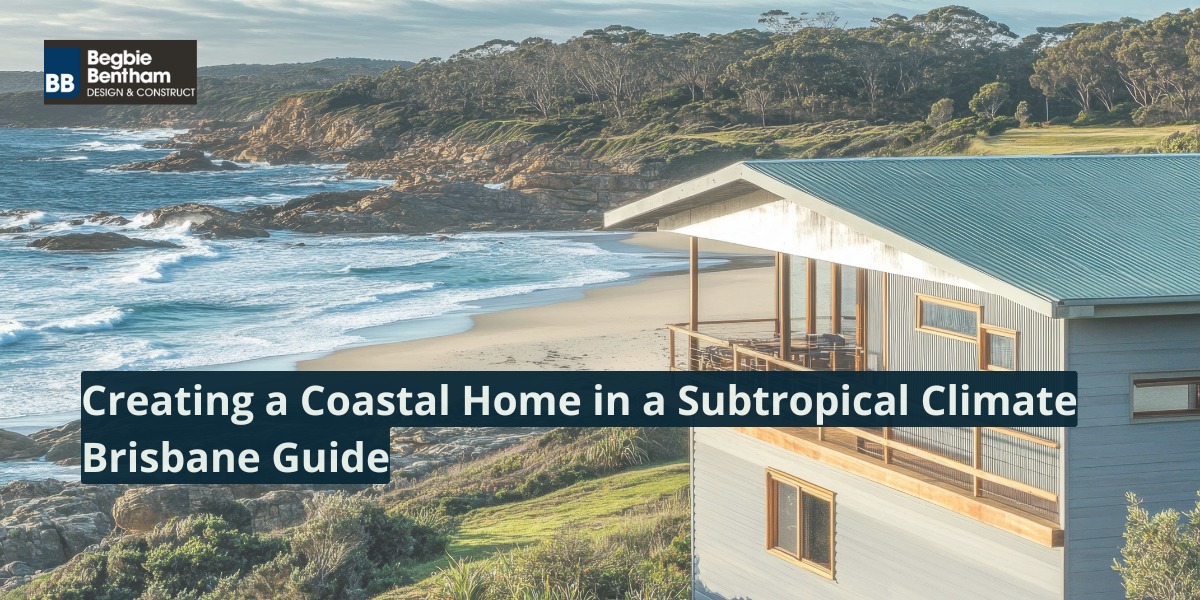A coastal home in Brisbane is a design approach that uses ventilation, natural light and open spaces to create comfortable living in our subtropical climate. The reason this works well is that Brisbane’s warm, humid weather needs the same cooling strategies that seaside houses rely on.
Now you might think coastal design only suits waterfront properties. But these same features keep houses cool in Ashgrove, Bulimba, or any Brisbane suburb. Once you understand how to work with our climate, you can bring that relaxed coastal feel anywhere.
So where do you start? This guide covers how to choose a location for better cooling, design features that suit our subtropical weather, and styling that builds on coastal charm. You’ll also get expert insights from builders like BegbieBentham, who specialise in energy-efficient homes designed for our climate.
Let’s begin with why our climate pairs so well with coastal design.
Why Brisbane’s Subtropical Climate Loves Coastal Home Design
Brisbane’s subtropical climate makes coastal home design easier and more practical than you’d think. Our area falls in Climate Zone 2, where summers are warm and humid, and winters stay mild. It’s one of the reasons the Brisbane City Council supports building designs that reflect our subtropical lifestyle.

The high humidity here is exactly why coastal features work so well. Your house needs constant ventilation to stay comfortable, which coastal design handles by default. Cross ventilation through wide openings keeps cool air moving while pushing hot air out.
Our year-round warm weather gives you another advantage. You might be wondering why it’s more necessary here than in cooler cities. It’s because we don’t face extreme cold that forces you indoors for months, so your outdoor spaces become actual living areas you can use daily.
Louvres and breezeways also help naturally solve stuffiness. One Hawthorne house we’ve worked with uses timber louvres across the upper floor. The owners rarely need their cooling systems, even during February’s peak heat.
Finding the Perfect Location for Your Coastal Home in Brisbane
The right location can cut your cooling costs in half while giving you that coastal breeze feeling. So, where you build has just as big an impact as how you build when creating your perfect coastal home in Brisbane.
Let’s break down what we mean:
Elevated Sites Catch More Breeze
Higher ground positions capture cooling breezes that ground-level blocks miss completely in Brisbane’s heat. That’s why ridge locations in suburbs like The Gap or Ashgrove give you natural ventilation without the necessity of air conditioning systems.
Brisbane Suburbs With Coastal Potential
Morningside and Hawthorne sit on elevated river bends with consistent breeze patterns throughout the year. Bulimba’s riverside position works the same way to create natural ventilation corridors for coastal designs.
We’ve built three homes in Bulimba over the past five years, and each one stays 4-6 degrees cooler than comparable houses just two suburbs west.
Site Orientation for Coastal Living
North-facing outdoor spaces capture winter sun while wide eaves protect from harsh summer overhead rays. Cross ventilation adds to this by positioning living rooms to catch prevailing south-east breezes.
When you align your windows and doors with these patterns, natural air flow reduces your need for cooling systems.
Design Features That Handle Subtropical Conditions
Once you’ve picked your site, the design features become the next piece of the puzzle. These elements work together to create a comfortable subtropical house:
Wide Eaves for Sun Control
Wide eaves extending 900mm or more block summer sun but let lower winter sun warm your rooms. Queensland building guidelines recommend this for Climate Zone 2 because it reduces heat gain during our hottest months. The shade stops direct sunlight from heating your interior spaces.
Raised Floors for Protection
Raising your floor 600mm above ground improves both airflow underneath and protects from Brisbane’s flash flooding. Brisbane’s February 2022 floods taught many homeowners this lesson the expensive way. And in our experience, houses raised 600mm stayed dry while ground-level slabs took weeks to recover.
Lightweight Building Materials
Timber frames and steel structures handle humidity better than brick because they breathe and dry faster. These lighter materials store less heat during the day, so your house cools down faster at night when temperatures drop.
Open Layouts for Airflow
Open-plan layouts let breezes flow through your home from front to back. When you remove walls between spaces, cross ventilation moves air naturally and reduces your need for cooling systems.
How to Make Your Coastal Home Energy Efficient Without Losing Style
Energy efficiency doesn’t mean sacrificing that breezy, relaxed coastal look you’re after. You can have both comfort and lower energy bills with the right design choices.

Here are a few options we recommend trying out:
Ceiling Fans and High Ceilings
Ceiling fans paired with high ceilings move air constantly and cost less to run than air conditioning. The combination creates natural circulation that keeps cool air flowing through your living spaces. Simply put, high ceilings let hot air rise away from where you’re sitting, while the fans push it back down after it cools.
Light-Colored Roofing
Pale Colorbond roofing in colours like Surfmist reflects solar radiation instead of absorbing it. Believe it or not, pale roofs can drop your indoor temps by 3-5 degrees compared to darker colours. So the lighter surface bounces heat away before it transfers through to your rooms.
Strategic Window Placement
Positioning windows on opposite walls creates pressure differences that pull breezes through without mechanical help.
One recent project in Coorparoo used strategic window placement to cut the homeowner’s summer cooling bills by 40% in the first year. These windows catch south-east breezes and let hot air escape on the other side.
Proper Insulation
Bulk insulation in walls and ceilings stops heat transfer while still letting your house breathe. The insulation creates a barrier against heat absorbed during the day to keep your interior cooler. This balance means you stay comfortable year-round without relying heavily on heating or cooling systems.
Coastal Styling Tips for Brisbane’s Indoor-Outdoor Living
Now that the technical side is sorted, the styling choices bring your coastal vision to life.
First of all, whitewashed timber and natural oak tones give you a relaxed beach feel without looking themed. These finishes reflect light instead of absorbing it, keeping your interior spaces cool and bright on hot days.
Next, outdoor-rated fabrics in coastal blues and sandy neutrals handle Brisbane’s UV exposure better than indoor materials (outdoor-rated fabrics last 5-7 years in Brisbane’s sun versus 2-3 years for standard indoor materials). The outdoor-rated versions maintain their colour on covered verandahs or in screened outdoor rooms.
Polished concrete floors also stay cool underfoot and won’t trap moisture the way carpet does in humid months. Concrete stores coolness overnight and releases it during the day, so your space stays comfortable at all times.
And lastly, soft blues, greens, and sandy beiges borrowed from Moreton Bay’s coastline keep rooms feeling calm and breezy. One Bulimba house used these coastal colours with pale blue walls and natural timber furniture. You’ll notice that this palette creates a sense of openness that connects your interior to the outdoors.
Your Coastal Home Starts Here
Coastal design solves Brisbane’s climate challenges while creating homes that feel relaxed and inviting year-round. Smart location choices, thoughtful features and energy-efficient systems give you a house that stays comfortable naturally. And you’ll spend less on cooling bills while enjoying better ventilation and natural light.
Ready to create your own coastal retreat? Contact Begbie Bentham‘s design team to create a coastal home suited to your block and lifestyle. Their 22 years of experience in Brisbane mean they understand how subtropical house design works for your specific site.
So it’s time to start your coastal home journey.





